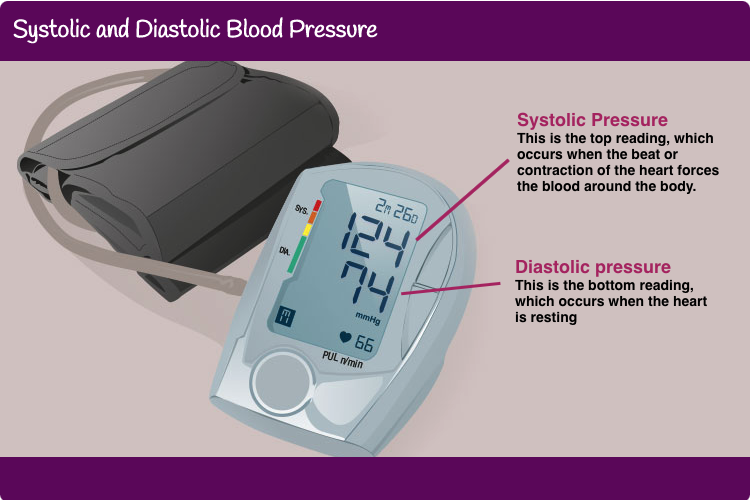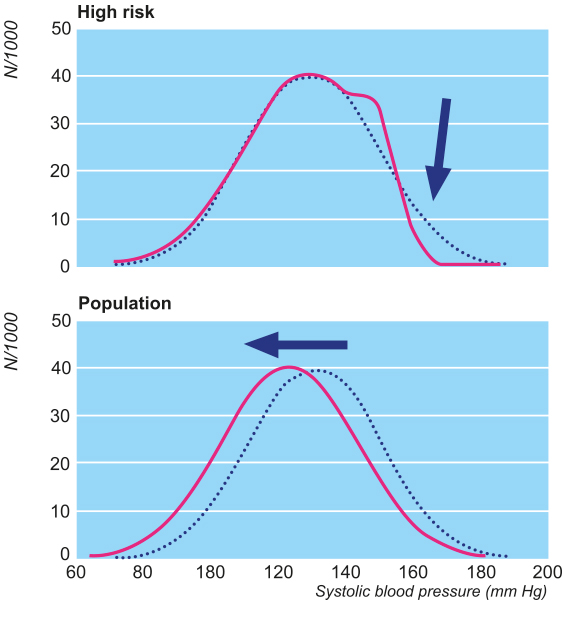Hypertension is persistently raised arterial blood pressure (BP) and is a cardiovascular risk factor. 1 in 4 people in the UK have high BP. People with high BP are three times more likely to develop heart disease and stroke and twice as likely to die from these as people with a normal BP (Ref: Department of Health (2001) The Annual Report of the Chief Medical Officer. www.doh.gov.uk). The risk associated with increasing BP is continuous, with each 2 mmHg rise in systolic blood pressure associated with a 7% increased risk of mortality from ischaemic heart disease and a 10% increased risk of mortality from stroke (Ref: NICE 2011 Guideline CG 127 (2011) Hypertension in adults: diagnosis and management).
- BP is normally distributed in the population.
- Investigation and management of sustained raised BP is undertaken at levels known to reduce the development or progression of disease, known as thresholds (Ref: NICE 2011 Hypertension The clinical management of primary hypertension in adults Clinical Guideline 127 Methods, evidence, and recommendations http://www.nice.org.uk/guidance/cg127/evidence/full-guideline-248588317).
- The thresholds for clinic BP readings are:
- Systolic BP sustained above or equal to 140 mmHg, or
- Diastolic BP sustained above or equal to 90 mmHg, or
- Both.
- The thresholds for Ambulatory BP Measurement (ABPM) or Home BP Measurement (HBPM) are:
- Systolic BP average above or equal to 135 mmHg, or
- Diastolic BP average above or equal to 85 mmHg, or
- Both
- Diagnosis is based on ABPM (or HBPM) (NICE 2011).

- The greater the level of systolic and/or diastolic BP the greater is the risk of mortality and morbidity associated with
- Coronary heart disease
- Stroke
- Peripheral vascular disease
- Retinopathy
- Aortic aneurysm
- Heart failure
- End-stage renal disease, or
- Dementia.
- Safe, effective, and inexpensive treatment options are available.
- National guidelines have categorised BP levels and used three stages of hypertension (also known as grades) to aid decision making for diagnosing and offering pharmacological treatment. The same grading is used in young, middle-aged and elderly subjects but not in children or teenagers.
| Category | Systolic | Diastolic | |
|---|---|---|---|
| Optimal | <120 | and | <80 |
| Normal | 120-129 | and/or | 80-84 |
| High normal | 130-139 | and/or | 85-89 |
| Stage 1 hypertension | 140-159 | and/or | 90-99 |
| Stage 2 hypertension | 160-179 | and/or | 100-109 |
| Stage 3 hypertension | >180 | and/or | >110 |
| Isolated systolic hypertension | >140 | and | <90 |
(Table Ref: The European Society of Hypertension (ESH) and European Society of Cardiology (ESC) (2013) ESH/ESC Guidelines for the management of arterial hypertension. J Hypertens 31:1281–1357 DOI:10.1097/01.hjh.0000431740.32696.cc)
Systolic Pressure
This is the top reading, which occurs when the beat or contraction of the heart forces the blood around the body.
Diastolic pressure
This is the bottom reading, which occurs when the heart is resting
Pulse point
Overall, the prevalence of hypertension in the UK is about 30–45% of the general population, with a steep increase with ageing. Prevalence varies across countries and among some ethnic groups, for example, with African or Caribbean descent the prevalence is higher. People from the most socially deprived areas are 30% more likely than the least-deprived to have high blood pressure (Ref: Public Health England (2014) High Blood Pressure: Data guidance and health service planning.)
Page last reviewed: 17 Sep 2020



